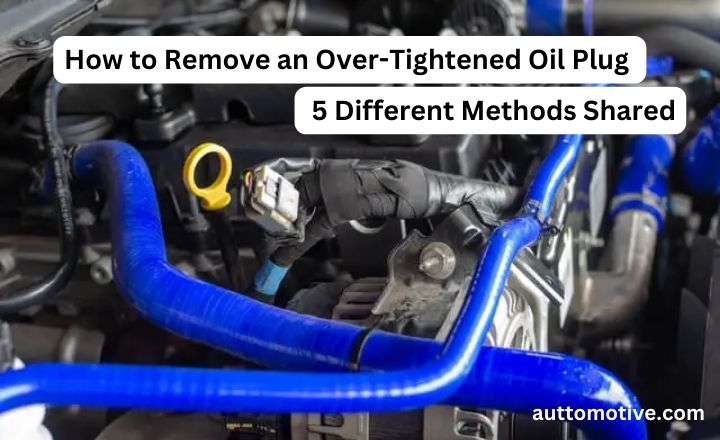Are you dealing with an over-tightened oil plug? If so, you’re not alone! Many car owners have experienced the frustration of removing an over-tightened oil plug. There are several methods to easily get the job done. In this guide, I’ll discuss five different ways that will cover how to remove an over-tightened oil plug so that you can get back on the road as soon as possible.
What Should You Do If You Remove an Over tightened Oil Plug?
Proper maintenance of your vehicle’s engine is essential for long life, including checking the oil level and inspecting the oil plug for any signs of damage or wear.
Unfortunately, removing an over-tightened oil plug can be difficult to put it back in place neatly. To avoid further damage, follow the steps before reinserting the oil plug.
➔ First of all use a torque wrench to loosen the bolt until it spins freely. This will give you more control while inserting the plug.
➔ Now, use pliers or adjustable wrenches to rotate the bolt counterclockwise until it loosens enough to insert into its hole.

How to Remove an Over-tightened Oil Plug
You’ll need a hex key slightly smaller than your oil plug’s socket head to do this. Once you’ve acquired one, slide it into the socket head and slowly turn counterclockwise until it loosens. It may not be easy at first as the bolt might be stuck in place; if this happens, use oil or lubricant to help loosen it up.
Using Lubricants to Remove an Overtightened Oil Plug:
Here’s how you can safely remove an over-tightened oil plug using lubricant.
You can lubricate the area around the oil plug with a high-performance lubricant such as WD-40 or penetrating oil spray. This will help make it easier for you to loosen the bolt and prevent any damage that could occur from using brute force. Once you’ve applied enough lubricant, wait a few minutes before unscrewing the plug.
Once sufficiently lubricated, grip the bolt and apply force counterclockwise until it loosens.

Gator Grip is used to remove an overtightened oil plug.
This revolutionary tool has been designed to make removing stubborn oil plugs easier.
The Gator Grip’s patented design is cleverly crafted to fit any shape or size, so tight oil plugs are no match for its multi-functional socket head. Its unique gripping technology easily holds fasteners of all shapes and sizes, giving you the confidence that those pesky bolts will come off in no time! The ergonomic handle gives you extra torque and leverage to ensure even the most challenging jobs are done quickly and safely.
Remove the oil plug and over-tighten it with a socket wrench:
You can also use a socket wrench to remove the oil plug and overtighten it. Doing this is relatively easy but requires some care and attention. Here’s a step-by-step guide on how to go about doing it correctly:
➔ Firstly, place your car on a flat surface and use the parking brake for safety.
➔ Secondly, locate the oil drain plug underneath your car near the engine block – a black cap or mark usually circles this.
➔ Once you’ve identified it, use your socket wrench to loosen the plug counterclockwise until it comes off completely.
➔ Then, hold an old rag or cloth under the area where you’re working to catch any dripping oil that may come out while working on this project.
A bolt extractor can be used to remove and overtighten the oil plug
A bolt extractor can be your best friend. These tools are designed to give you enough torque and leverage to do the job quickly and safely. Plus, they come in various sizes, so you can always find one that fits your vehicle.
Using a bolt extractor is easy! All you need is basic knowledge of mechanics and the right tool for the job easy peasy! Once it’s in place, apply pressure until the plug comes loose or tightens up in whichever direction you go!
Conclusion
Knowing “How to Remove an Over-Tightened Oil Plug” is important. You can tackle this situation without damaging your engine parts using the five methods. It is also wise to check your vehicle’s manual for specific instructions on removing the oil plug and ensure you have all the necessary tools before attempting a repair. Always wear protective gear when working near high temperatures and follow all safety protocols.
Also Read: Do you Check Transmission fluid while the Car is running | Expert Tips?
Frequently Asked Questions
How Can An Overtightened Oil Plug Be Best Removed?
• Use a crash dryer and warm it to extend the length of the metallic strip. You run a couple of pliers to disable it.
• Another way is to get a mallet to aid you with the procedure. Next, place it down over the wrench handle, then place the flat tip of the wrench under the over-tightened bolt and swing away to loosen it.
What is your best tip for removing the oil plug?
Fold up a piece of gauze to serve as padding, then plug it into a socket, position a rag around the plug, and leave the sponge intact for a while.
How do you take out the rounded-off oil drain plug?
You can use a medium-sized flathead screwdriver to unscrew it. Also, use a more compact wrench to become better leverage.
What happens if you over-tighten an oil drain plug?
• It can most commonly lead to the threads on the plug or the threads in the oil pan being stripped or damaged. This can result in a leaky drain plug, which will cause your engine to eventually run out of oil and damage itself.
• Another issue that over-tightening may cause is damage to the gasket between the plug and the pan. If this happens, it will also create a leak that could lead to engine failure.
Is it okay to drain the oil overnight?
It is generally not recommended to drain oil overnight. Oil should be drained while the engine is still warm, as this helps to remove all of the old oil from the engine. If you leave the oil in for an extended period, it can start to break down and form sludge which can cause damage to your engine over time.

